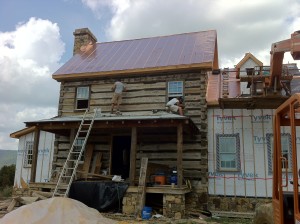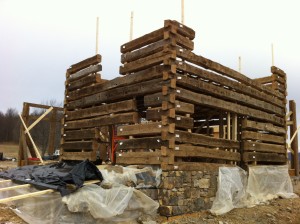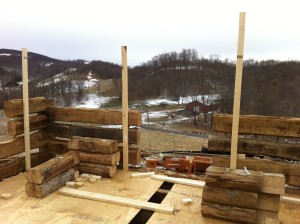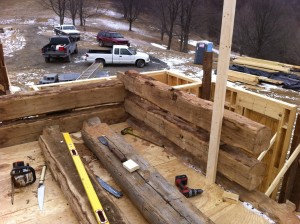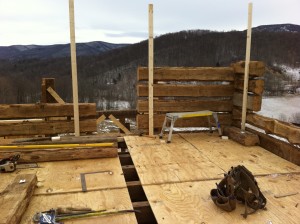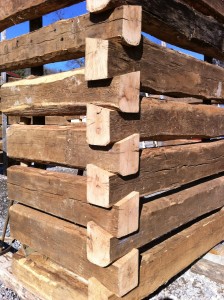Log cabin construction details
Noah Bradley2019-06-29T09:58:26+00:00OK… here’s the last photo of the log cabin partially assembled… I thought there were some details here that I ought to point out (for those interested).
You can clearly see the tags that are nailed near the ends of the logs that tell us which log goes where (remember this cabin was pre-assembled on a wood yard… there are several benefits to doing it that way)
All the messy plastic that you see is to protect the newly laid stonework from freezing in the cold night air. It makes a big difference. If fresh mortar freezes before it sets it will fail and crumble out just like sand.
Originally posted 2015-07-08 14:00:11.
Bragging logs
Noah Bradley2019-06-29T09:58:25+00:00Just look at all those cute little logs laying on the plywood decking… they are all notched, numbered, and ready to be set into place. They are so short because a window is close to the that corner.
I call these logs… “bragging logs”. It never fails that the man who gets to lay a corner like this will do so quickly and then brag about how great he is because he once set three courses of logs in five minutes… by himself.
Originally posted 2015-07-08 13:48:04.
On being a purist
Noah Bradley2019-06-29T09:58:24+00:00No one will ever call me a purist.
Now, I have done my share of historic restorations, but my preference is building new homes that are traditionally designed while also incorporating antique and locally available materials wherever I can.
Here we see in this photo huge 19th century oak logs, nearly eight inches thick and each well over a foot in height. And, you can see plenty of new lumber as well. I use the best of materials that are available, from whatever era they were made.
And, the same strategy holds true for the tools we use. If you look closely you will see a modern chainsaw, and next to it a Japanese hand saw, then on top of a log you will see a large antique chisel known as a slick, for the fine shaving of large pieces of wood such as the notching of a log cabin. And next to that slick, is a large sledge hammer for those times when a log needs convincing who is the boss.
Originally posted 2015-07-07 21:50:13.
How to set logs on a cabin
Noah Bradley2019-06-29T09:58:23+00:00Here you can see a temporary layer of plywood has been laid down over top of the old floor joists. This gives the crew a floor to work off of while they set the second floor logs into place.
Notice the vertical two-by-fours which are nailed to the logs temporarily while the logs are being set to hold these massive pieces of wood in place. Once the logs are all up we will do a final alignment on them, then install the permanent window and door jambs, and then, remove these “sticker” boards.
One final detail that I notice in this photo is the tool belt which is seen in the bottom right of the image. That tells me that the photo was taken at lunch-time. It seems that when lunch is called these heavy belts just drop to the ground right where the carpenter once stood… almost as if he had been raptured.
Originally posted 2015-07-07 21:30:00.
The best log cabin notch
Noah Bradley2019-06-29T09:58:18+00:00The log guys worked on “dry fitting” the cabin’s logs.
My favorite notch is a half-dovetail. It’s attractive and easy to make. The half-dovetail, and the V-notch, are the most common notches found on old old cabins. One other great advantage of the half-dovetail is that any water that might find its way into the joint is pulled back outside due to the slope of the notch.
This cabin is made from logs that were salvaged from an old barn. I really like barn logs, they are generally more massive in size than house logs and in better condition… they have not experienced any “home improvements” over the years.
Originally posted 2015-07-06 14:28:59.
The Back of the Cabin
Noah Bradley2019-06-29T09:58:11+00:00Here is the back of this log home.
The additions off of all three sides of the main house are “timber-framed”, using antique framing members from an extremely early 19th century home. (I’ll share some photos of that going up soon)
The addition off of the back serves as the home’s kitchen with a nearby porch on both sides… one being visible in this photo. Half of the kitchen offers a cathedral ceiling all the way to the peak of the roof, and the other half has a bedroom loft above it (you can see the shed dormer that brings lots of light into that sleeping space).
A lot of homes in this area feature exterior covered entrances to the basement and that is what we added to the end of this addition.
The little room seen around the chimney serves as office.
Originally posted 2015-07-04 14:34:52.


